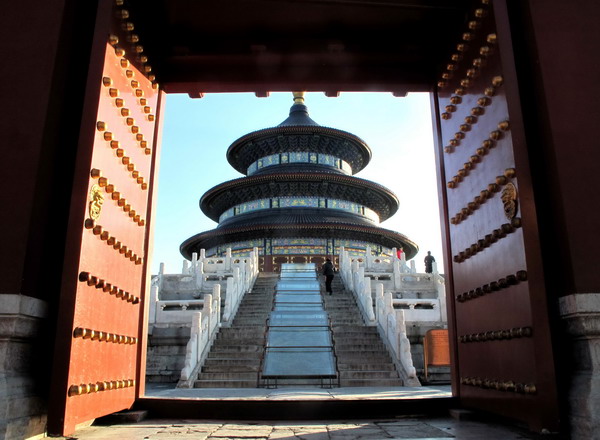

The Temple of Heaven where emperors used to hold ceremonies to pray to heaven.WANG HUI
Saunter north and cross the main street - you may have to take the underpass - you'll find yourself inside Tian'anmen Square, the political heart of China. There's the Chairman Mao Memorial Hall at the center, the Great Hall of the People to the west and the Chinese National Museum to the east, but not all of them may be open on any given day. But no matter, the outdoor part is where the awe is, being the largest square in the whole world and carrying all the political and historical gravitas associated with it.
Where the square ends, the Forbidden City begins, at least as it stands now. Pass through the guard-protected Golden Water Bridge and the thick walls of Tian'anmen Rostrum, and - viola - you're inside the palace proper, now officially known as the Palace Museum. You have to plan carefully because you can sprint across it in one hour or take a full day and still won't finish a portion of it. A reasonable plan is to have lunch at Qianmen and spend a whole afternoon in the square and the palace. That involves miles of walking.
You may want to skip the small hill where the last Ming emperor killed himself and ended a dynasty, but you should probably have dinner in the Drum Tower area where traditional food is in abundance. When dusk sets in, it's time to travel further north and discover new Beijing.
The Olympic Green is a strip lying north of the Fourth Ring Road. The Forest Park to its north is twice the size of New York's Central Park. But as you are on a tight schedule, the Bird's Nest and the Water Cube offer the best concentration of must-see sights. Or you may want to spread out activities for this day into two more leisurely days.
Day 3
If your feet ache miserably from the previous days' sightseeing, you may want to slow down. Skipped the National Museum? No problem, you can make it up with a trip to the Capital Museum where the exhibits have more surprises. Take a stroll along Wangfujing, the modern shopping street. The walking is much less intensive and the budgeted time much more flexible.
In case you are wondering how Beijingers used to live, you'll need to veer from the grand architecture and into the residential alleys, known as hutong. The South Gong and Drum Lane (Nanluoguxiang) is a good choice because it also functions as a bohemian enclave frequented by arty types. There is even a tiny theater where expats put on English-language plays.
A short walk northwest takes you to Shichahai, a lake surrounded by more bars and hutong. The traditional and the modern blend seamlessly into each other.
You may want to finish the day off by catching a performance of Peking Opera. I'd recommend one of those easy-to-digest shows customized for international travelers, but if you're more adventurous, there's more variety at the National Center for the Performing Arts - less touristy, more authentic and of a much higher caliber. The venue itself is worth the price of admission.
Day 4
This day is designed for those with boundless energy and who have finished all stops on the previous portion of the schedule.
The Summer Palace in a northwestern suburb of the city is a sprawl of exquisite corridors and a huge lake. Before it was built, there was the Old Summer Palace, or Yuanmingyuan, which was looted and burned down in 1860 during the Second Opium War. The ruins are a stark reminder of imperialist invasion and feudal impotence.
Buddhism is a major religion in China, with millions of temples dotting the nation's landscape. You cannot possibly avoid them when you venture deep into the country. But inside Beijing, the Lama Temple, though not a typical site of worship for most Chinese, has a unique fascination. It is a symbol of Tibetan Buddhism.
If people watching at Shichahai is tantalizing, you may want to spend the last night in Beijing in Sanlitun, the serious nightlife area and a favorite with the hip crowd, local and foreign. Here, bartenders may be able to speak English and the favorite drink of your homeland could be available.
Beijing has many charms, which it reconciles in a vibrant mix of rhythm and imagery. It may not represent all of China, but it is a pretty good place to start exploring the wonders of the whole country.
Repulse Bay, Hong Kong‘s most popular beach
2014-02-27Savoring Chengdu and its spicy form of gossip
2014-02-26Copyright ©1999-2018
Chinanews.com. All rights reserved.
Reproduction in whole or in part without permission is prohibited.